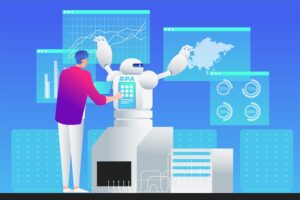The future of ChatGPT and other AI-powered language models is likely to be shaped by advancements in AI research and the growing demand for natural language processing technology. Here are some potential areas of growth for ChatGPT and NLP in the future:

Increased Interactivity
Yes, increased interactivity is one of the key areas of growth for ChatGPT and other AI language models. As technology improves, these models are likely to become more interactive, allowing for more nuanced and dynamic conversations.
For example, ChatGPT and other AI language models may be able to respond to follow-up questions. They engage in multitasking conversations and understand more complex and context-aware questions. This will provide a more natural and engaging experience for users. They allow for a wider range of applications and use cases.
AI language models may also be integrated with other technologies. For example such as virtual assistants or chatbots, provide a more seamless and intuitive interaction for users. This could result in a more personalized and user-friendly experience. Make AI language models more accessible and useful for a wider range of people.
Overall, increased interactivity is a crucial aspect of the future of ChatGPT and AI language models. They will likely play a significant role in shaping the future of human-AI interaction.
Integration With Other Technologies
Integration with other technologies is another important area of growth for ChatGPT and AI language models. As these technologies continue to evolve, there is a growing demand for seamless integration with other systems and tools.
For example, ChatGPT and other AI language models may be integrated with virtual augmented reality (VR/AR) systems. They provide more immersive and interactive experiences. They may also be integrated with other AI technologies, such as computer vision and robotics. To provide a more comprehensive and integrated AI solution.
In the healthcare industry AI language models like ChatGPT may be integrated with electronic health records (EHRs). Other healthcare technologies provide more efficient and effective patient care. In the finance industry, they may be integrated with financial management systems to provide more personalized and accurate financial advice.
In addition to these applications, the integration of artificial intelligence language models with other technologies will likely lead to the development of new and innovative solutions, across a wide range of domains and industries. This integration will provide new opportunities for AI language models to make a positive impact on society and improve people’s lives.
Overall, integration with other technologies is a key area of growth for ChatGPT and AI language models and will play a crucial role in shaping the future of these technologies and their impact on society.
Greater Accessibility
Greater accessibility is an important aspect of the future of ChatGPT and AI language models. As these technologies become more widely used, it is important to ensure that they are accessible and usable for everyone, including people with disabilities and those who may have limited proficiency in the language in which the model is trained.
One of the ways that ChatGPT and other AI language models can become more accessible is through the development of alternative input and output methods. For example, AI language models may be integrated with speech recognition and text-to-speech technology to provide a more accessible experience for people with visual or mobility impairments.
Another important aspect of accessibility is language support. As AI language models like ChatGPT continue to improve their multilingual capabilities, they will become more accessible and useful for a wider range of people, regardless of their language or cultural background.
Finally, accessibility also involves ensuring that AI language models are transparent, ethical, and unbiased. As these technologies become more widely used, it is important to ensure that they are designed and used in ways that are fair and equitable for everyone.
Overall, greater accessibility is a crucial aspect of the future of ChatGPT and AI language models and will play an important role in shaping the responsible and ethical development and deployment of these technologies.
Wider Range Of Applications
The wider range of applications is a key area of growth for ChatGPT and other AI language models. As these technologies continue to improve. They are being used in an increasingly diverse range of domains and industries. From healthcare and finance to education and entertainment.
For example, in the healthcare industry, AI language models may be used to help diagnose diseases, provide patient care assist with medical research. In the finance industry they may be used to provide financial advice. Make investment recommendations, and manage portfolios in education. They may be used to provide personalized learning experiences, answer student questions, and assist with research projects.
In addition to these applications, AI language models may also be used to generate creative content, such as music, poetry, and fiction. They may also be used to assist with administrative tasks, such as data entry, customer service, and appointment scheduling.
The wider range of applications for ChatGPT and other AI language models is driven by their ability to understand and interpret the human language to provide accurate and effective responses. As these technologies continue to improve, we will likely see even more diverse and innovative applications for AI language models in the future.
Overall, the wider range of applications is a key area of growth for ChatGPT and AI language models and will play an important role in shaping the future of these technologies and their impact on society.
Advancements In Natural Language Generation
Advancements in natural language generation (NLG) are a crucial aspect of the future of ChatGPT and other AI language models. NLG refers to the ability of these models to generate human-like text based on input data and algorithms.
As AI language models like ChatGPT continue to improve. We expect to see advances in their ability to generate more natural and fluent text.AI language models may be trained to understand the context and incorporate it into the next generation resulting in more accurate and relevant responses. They may also be trained to understand the tone and style of different genres. Such as poetry or news articles to generate text in these styles.
Advancements in NLG will significantly impact a wide range of applications and industries. For example in journalism and media, AI language models may be used to generate news articles, and summaries other forms of content in education. They may be used to generate personalized lesson plans and educational materials in the marketing industry. They may be used to generate product descriptions and promotional materials.
Finally, advancements in NLG will also have implications for the development of more advanced AI systems, such as virtual assistants and chatbots. As these systems become more capable of generating natural and human-like text. They will provide a more seamless and intuitive interaction for users.
Overall, advancements in natural language generation are a key aspect of the future of ChatGPT and AI language models. They will play a crucial role in shaping the future of these technologies and their impact on society.
Conclusion
Overall, the future of ChatGPT and NLP technology looks promising. With the potential for significant growth and expansion into new areas. However, it is important to consider the potential ethical and societal implications of these technologies and work to ensure their responsible development and use.
FAQs
What is ChatGPT?
ChatGPT is an AI language model developed by OpenAI it is trained on a large corpus of text. They can generate human-like responses to text inputs.
How does ChatGPT work?
ChatGPT uses a deep learning technique called transformers to generate text. It takes an input sequence of text and uses an attention mechanism to predict the next word in the sequence. The model is trained on a large corpus of text data and can generate responses based on the patterns and relationships it has learned from the training data.
What can ChatGPT be used for?
ChatGPT can be used for a variety of applications, including question-answering, content creation, customer service, and more. Its ability to generate human-like text based on input data makes it a useful tool for a wide range of industries and domains.
Is ChatGPT biased?
Like any AI system, ChatGPT is only as unbiased as the data it is trained on. If the training data contains biases, the model may also exhibit these biases in its output. It is important to be aware of this and to work towards reducing bias in AI language models.

